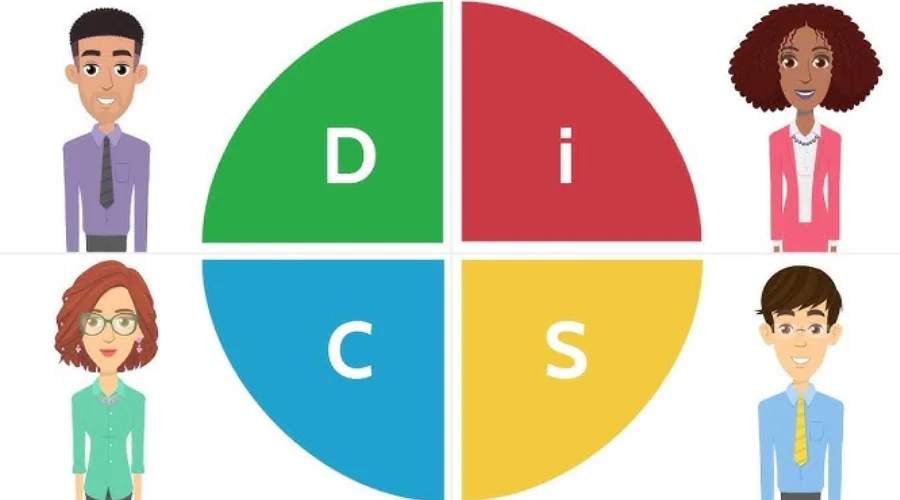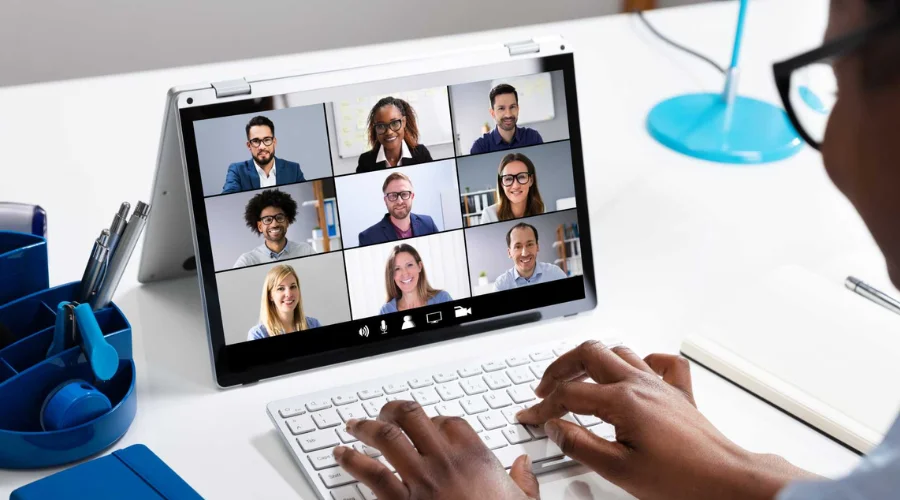Table of content
DISC Communication in Remote Teams: How to Build Stronger Virtual Connections
Learn how DISC communication in remote teams improves collaboration, reduces conflict, and helps leaders connect effectively in virtual environments.
Table of content
Remote work has changed how teams talk and connect. Without face-to-face contact, messages can feel unclear or cold. DISC communication in remote teams helps fix that. By understanding how each person speaks and reacts, leaders can build stronger trust and teamwork. It turns confusion into connection and helps every member feel heard. This guide will show how to use DISC to improve clarity, collaboration, and balance in virtual work.
What Is DISC Communication and Why Does It Matter in Remote Teams?
The DISC model explains how people behave and communicate at work. It categorizes people into four types - Dominance (D), Influence (I), Steadiness (S), and Compliance (C) - each with a unique set of strengths and needs.
Each group shows a different way of speaking, reacting, and working with others. These differences have a big impact on how remote teams connect and perform:
- D-style: Direct and focused on results. They prefer short, clear messages and fast decisions. Too much discussion or delay can frustrate them.
- I-style: Friendly and enthusiastic. They like open talks and regular feedback. Without social contact, they may feel disconnected in remote work.
- S-style: Patient and supportive. They value harmony, clear plans, and steady routines. Sudden changes in remote settings can make them stressed.
- C-style: Careful and detail-oriented. They need structure, data, and well-defined rules. Vague instructions can cause confusion or worry.
In a remote environment, applying DISC communication in remote teams becomes especially important. Without face-to-face cues and casual conversations, misunderstandings escalate more easily. When teammates and leaders adapt messaging to each style, it fosters higher trust, smoother collaboration, and improved efficiency.
Knowing each person’s preferred interaction method helps reduce conflict and keeps productivity strong, even across distance.
By applying DISC communication in remote teams, managers can guide interactions more effectively. It keeps everyone engaged, improves collaboration, and helps remote employees feel valued and connected - no matter where they are.

The Impact of Remote Work on Team Communication
Working remotely changes how people connect and share ideas. Without face-to-face contact, it becomes harder to read emotions or build quick trust. That’s why DISC communication in remote teams plays a key role in keeping everyone aligned and supported.
Loss of natural cues
In an office, people rely on tone, body language, and facial expressions. Online, those signals are missing. Messages can feel flat or unclear. Even simple feedback can be misunderstood. For distributed teams, using clear and intentional words matters more than ever. Tools like video calls help, but they cannot fully replace real-life connection.
Impact on teamwork and motivation
When communication feels distant, some members start to feel unseen or left out. That emotional gap can lower morale and weaken team spirit. Regular check-ins, open discussions, and personal feedback help keep everyone connected. Building a sense of belonging is essential for any remote team.
Making connection intentional
Strong remote teams don’t rely on chance. They build habits that support interaction and empathy. Setting clear meeting rhythms, using shared dashboards, and allowing space for informal talk all help bridge distance. With thoughtful planning, DISC communication in remote teams can create stronger understanding, higher trust, and better results - even from afar.
Benefits of DISC Communication in Remote Teams
Understanding and applying DISC communication in remote teams helps leaders and members work together more effectively. It makes collaboration smoother, reduces tension, and boosts team morale.
1. Clearer and More Effective Messages
Each DISC style has a unique way of communicating. Knowing these preferences helps everyone express ideas clearly and avoid confusion.
- Dominance (D) types want short and direct updates.
- Influence (I) types enjoy friendly discussions.
- Steadiness (S) and Conscientiousness (C) styles value calm tones and clear details.
When communication fits each person’s style, virtual conversations become faster and more meaningful.
2. Stronger Teamwork and Connection
Using DISC communication allows leaders to match different personalities for better results. Pairing outgoing I types with careful C types often creates balanced thinking. At the same time, steady S types help keep projects on track while D types push for progress. This mix encourages creativity and trust within remote teams.
3. Higher Morale and Motivation
People feel valued when managers adjust their approach based on DISC insights. Giving a D-style member more independence or offering an S-style worker steady support can make them feel appreciated. When employees feel understood, their engagement and confidence rise.
4. Fewer Conflicts, Faster Solutions
Misunderstandings are common in virtual settings. With DISC communication in remote teams, members learn how to read behavior instead of guessing intent. This skill reduces emotional tension and helps resolve disagreements quickly.
5. Better Performance and Shared Understanding
When everyone uses a shared DISC language, feedback and teamwork become simpler. Leaders can plan meetings, delegate work, and share updates in ways that match each style. As a result, remote collaboration feels smoother, and productivity naturally improves.

Understanding DISC Communication Styles in Remote Settings
When working with distributed teams, the way people Working remotely changes how people talk and connect. DISC communication in remote teams helps leaders and members understand how to adjust their tone, words, and timing. When you match your style to others, remote working teams becomes smoother and more productive.
The Dominance (D) Style
People with a D style like communication that is direct, clear, and fast. They focus on results, not small talk. In remote work, one of the biggest remote teams challenges for D types is slow updates or unclear instructions.
Tips for working with D types:
- Provide clear goals and expectations at the start of a task.
- Get to the point quickly. Avoid long preambles before stating what you need.
- Limit micromanagement but maintain accountability via structured check-ins or progress reviews.
- Assign work through email or dashboards with clear tasks and deadlines.
- Do not hold meetings without an agenda.
Such practices reduce frustration and help D-types stay focused and motivated.
The Influence (I) Style
The I style thrives on connection and encouragement. They enjoy social interaction and quick feedback. In remote working teams, they may lose motivation if isolated from others. Ways to support them:
- Use video calls or lively chats to keep them connected.
- Create group discussions where they can share ideas freely.
- Make sure they feel heard. Respond quickly and show appreciation.
- Let them lead brainstorming sessions or virtual team games.
These habits keep I types engaged and excited about working as a team remotely.
The Steadiness (S) Style
People with an S style value consistency, calm collaboration, and predictable structure. Sudden shifts or ambiguity in remote work can unsettle them. To support S-types:
- Maintain a regular schedule (e.g. fixed meeting times, recurring updates).
- Always provide a meeting recap or written summary afterward so they feel assured about what was decided.
- Offer personalized feedback and a stable workflow rather than abrupt changes.
- Avoid long, complex explanations - use simple, digestible messages to ease comprehension.
Consistency and reassurance help S-types feel secure and effective in remote settings.
The Compliance (C) Style
People with a C style are careful, logical, and organized. They want data, not guesses. In remote teams, they need structure to do their best work.
Tips for working with C types:
- Provide clear and detailed instructions before they start a task.
- Share guidelines, checklists, and timelines so they can plan ahead.
- Use task-tracking tools to help them stay on schedule.
- Be factual and specific. Avoid vague requests or emotional language.
A structured system gives C types confidence and ensures high-quality results.

How to Apply DISC Communication to Improve Remote Collaboration
Good DISC communication in remote teams helps leaders build trust and teamwork. It makes online work smoother and reduces confusion. By adjusting how you speak, choosing the right channel, and using shared language, remote teams can stay connected and aligned.
Match Your Communication Style to Others
When leading a remote team, your communication approach should fit the personality of each member.
- With D-style individuals, focus on results and key actions.
- With S-style members, highlight reliability and calm teamwork.
By applying DISC communication in remote teams, you can tailor your tone and pace to match different personalities. This creates smoother conversations and better collaboration in virtual settings.
Choose the Right Communication Channel
Selecting the right channel helps keep messages clear and productive. Each DISC style responds better to a specific method of communication:
- Use email for C-types who value structure and written details.
- Use chat or quick messages for D-types who want fast updates.
- Use video calls for I-types who enjoy face-to-face energy.
- Use one-on-one meetings for S-types who prefer calm discussion.
Adapting your tools based on DISC styles makes remote collaboration more effective. It builds trust and keeps your team connected, even when working apart.
Build a Shared Language for Team Alignment
When everyone understands the DISC model, communication becomes easier and more natural. Team members can recognize different behaviors and adjust their responses.
This shared approach makes DISC communication in remote teams a common language. It cuts down on stress, builds stronger relationships, and helps every member feel part of the same mission.
Encourage Emotional Awareness in Team Communication
Good communication depends on emotional awareness. Knowing how people react under pressure helps avoid conflict in remote work.
Watch for emotional cues in chats or calls - short replies, silence, or tense wording may signal stress. Adjust your tone based on each DISC type:
- D types need quick reassurance.
- I types enjoy open and friendly talk.
- S types value calm and empathy.
- C types prefer clear, logical updates.
When leaders stay aware of emotions, they build trust and make teamwork smoother.

Managing and Resolving Communication Conflicts Using DISC
Even strong remote teams can face misunderstandings. Using DISC communication in remote teams helps leaders spot issues early and guide smoother interactions between different personality types.
Common Remote Conflicts by DISC Type
Each DISC style reacts to remote communication in unique ways. Understanding these differences helps reduce frustration and tension.
DISC Style | Typical Tension in Remote Work | Common Source of Misunderstanding |
D (Dominance) | Frustrated by delays, abrupt tone | May be seen as harsh or impatient when pushing for results |
I (Influence) | Feels isolated, misses social energy | Might avoid direct criticism, leading to passive tension |
S (Steadiness) | Disturbed by sudden changes or ambiguity | Hesitates to speak up, conflict can fester under the surface |
C (Compliance) | Discomfort with vague instructions or shifting expectations | Overanalyzes details, possibly seen as slow or overly critical |
Because remote work already limits nuance, these style-based tensions often flare up more quickly than in face-to-face settings.
Strategies to Prevent Miscommunication
Small, consistent adjustments can make communication clear and positive across every DISC style.
1. Adapt your tone and message
- Use short, action-focused messages for D types.
- Keep I types engaged with friendly, open talk.
- Give S types clear routines and calm updates.
- Provide C types with structure and full context.
2. Set shared communication rules
- Decide together how and when to reply to messages.
- Use the same channels for key updates to avoid confusion.
3. Use DISC to express needs clearly
- Encourage teammates to say what helps them work best.
- Replace blame with “I need…” statements to keep the tone respectful.
4. Watch for early signs of conflict
- Look for short replies or delays in messages.
- Address issues fast with a quick check-in call.
5. Build flexibility across styles
- Let team members practice new approaches.
- Celebrate when people adapt their style to support others.
By applying these steps, you create trust, clarity, and smoother DISC communication in remote teams, even across time zones and digital platforms.
Implementing DISC Communication Practices in Remote Teams
Strong DISC communication in remote teams helps people stay connected and understood. When each member knows how others work and speak, collaboration becomes easier. Using DISC every day keeps communication clear and teamwork smooth.

Start with a Team DISC Assessment
Begin by asking everyone to take a DISC test. It shows each person’s style, pace, and motivation. Once you get the results, hold a short online meeting to share and discuss them.
Let team members talk about what helps them work best. Some prefer direct answers. Others need time to think before replying. Understanding these habits builds trust and reduces confusion.
This first step gives your team a shared language. It helps people express what they need and respect each other’s way of working. It’s the base for strong DISC communication in remote teams.
Incorporate DISC into Meetings and Workflows
Use DISC insights in daily tasks and virtual meetings. This helps every style feel comfortable and engaged.
Try small changes such as:
- Keep meetings short and focused for Dominance (D) types.
- Add time for friendly talk to energize Influence (I) types.
- Maintain clear routines for Steadiness (S) types.
- Share notes and structure for Conscientious (C) types.
Simple adjustments like these create smoother discussions and fewer mistakes. Each person feels included and motivated to share ideas.
Facilitate Ongoing DISC-Based Adjustments
Good DISC communication in remote teams grows over time. Review how your team connects every few months. Ask what works and what feels difficult.
When someone new joins, have them take the DISC test too. Introduce their results to the group so everyone learns how to support them.
Keep adjusting your approach. Small updates keep the team flexible and balanced. When people feel heard and understood, remote teamwork stays strong and enjoyable.
Encourage Style-Based Feedback
Regular feedback keeps DISC communication in remote teams healthy and open. Ask each member how they prefer to receive feedback - in writing, in meetings, or one-on-one.
Use their DISC type to guide your approach:
- D types value direct and quick input.
- I types respond best to positive, encouraging words.
- S types appreciate calm, supportive talks.
- C types prefer detailed, structured notes.
When feedback matches personality, people listen better and act faster. It also builds mutual respect and reduces tension in remote work.
Use DISC to Strengthen Team Recognition
Recognition keeps motivation high in remote settings. Link your appreciation style to each DISC personality.
For example:
- Praise D types for their leadership and results.
- Highlight I types for their creativity and energy.
- Thank S types for their reliability and teamwork.
- Acknowledge C types for their precision and quality.
By personalizing recognition, you make people feel seen and valued. This approach deepens trust and strengthens long-term DISC in remote teams.
Conclusion
Strong virtual teams don’t just depend on tools - they depend on understanding. DISC communication in remote teams gives leaders and members a simple way to connect better every day. When people know how others think and respond, teamwork feels easier and more human. By using DISC to guide tone, timing, and feedback, remote teams can stay clear, confident, and connected - no matter where they work from.
FAQs
1. Which DISC type works best in remote environments?
There is no single DISC type that fits remote work best. Each type brings value. D types act fast and lead with confidence. I types build energy and connection. S types create calm and stability. C types add detail and structure. A strong remote team uses DISC communication in remote teams to balance these strengths and support all styles equally.
2. Can DISC training improve virtual meeting effectiveness?
Yes. DISC communication makes virtual meetings clearer and easier. When people understand each DISC style, they adjust how they speak and listen. D types prefer short, direct talk. I types like open, friendly sharing. S types need steady pacing, and C types want clear points. This awareness helps meetings stay focused, inclusive, and productive for everyone.
3. How often should teams review their DISC profiles?
Teams should review their DISC profiles every six months or when new members join. People’s work styles can shift over time, especially in remote roles. Checking regularly keeps the team aligned and aware of changes. This practice helps DISC communication stay useful, clear, and supportive as goals, people, and projects evolve.
4. How can leaders apply DISC insights to boost remote engagement?
Leaders can use DISC communication in remote teams to keep people engaged. D types like clear goals and freedom to act. I types enjoy recognition and group energy. S types want steady support, and C types prefer clear plans. Matching motivation to each style helps everyone stay focused, valued, and connected - even while working apart.


Don't Let Your Potential Stay Hidden!
Take the DISC test today and discover your unique 'YOU', with deep insights into your true personality and potential.

Represents your instinctive behaviors and desires.
Shows the behavioral tendencies you think you should exhibit in specific situations.
Related articles
You may also be interested in
 DISCDec 02, 2025
DISCDec 02, 2025Compatibility of Personality Types: How Different People Connect & Work
Discover the Compatibility of Personality Types and how different traits connect. Learn how strengths and differences shape deeper, more lasting bonds.
 DISCNov 21, 2025
DISCNov 21, 2025DISC Working Styles: Understand Your Style and Work Better with Team
Unlock the power of DISC working styles to boost teamwork, communication, and leadership. Discover your style and learn how to work smarter with any team.
 DISCOct 24, 2025
DISCOct 24, 2025Selling to Different Personality Types: How to Adapt and Close Deals
Learn how to sell to different personality types with the DiSC model. Master your communication skills to connect, persuade, and close deals effortlessly.
